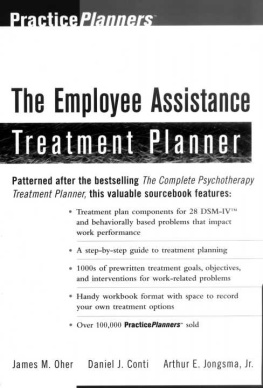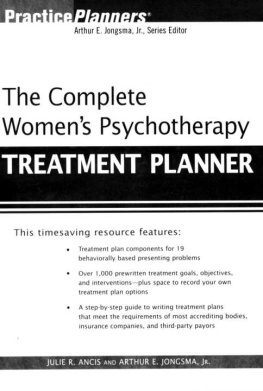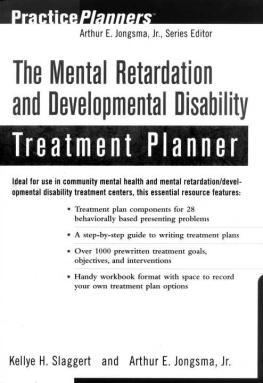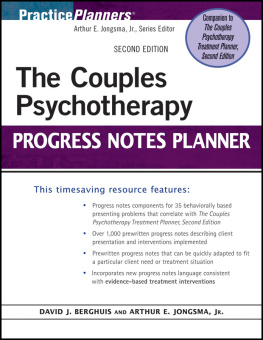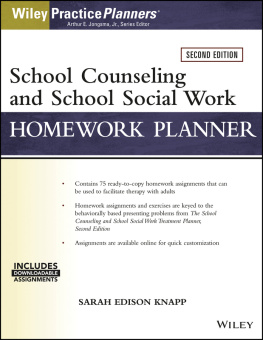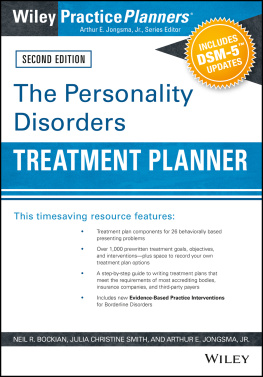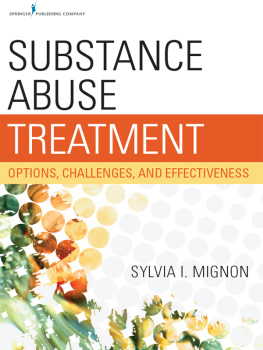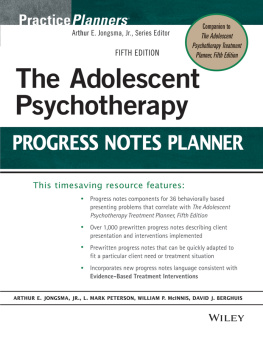James M. Oher
Daniel]. Conti
Arthur E. Jongsma, Jr.





CONTENTS
The Employee
Assistance
Treatment
Planner
INTRODUCTION
Work organizations and the nature of work itself will be transformed as the demand for change continues throughout this decade. Partially as a response to this resulting disequilibrium, Employee Assistance Programs (EAPs) are increasingly being offered by workplaces throughout the world to attend to the emotional, social, and psychological needs of employees. Employee Assistance Services are workplace-focused mechanisms designed to identify and aid employees who need professional assistance with problems in living that frequently impair their job performance. These problems in living are often connected to alcohol and other drug use, or marital, emotional, familial, and other stressors.
EAP work requires a clarification and prioritization of the problems that the employee presents. This Planner helps the EAP counselor with these needs and addresses the causes of job performance problems with step-by-step suggestions on how to resolve them. The Planner also provides direction and focus for the referral to community resources that may be needed to comprehensively address the problem. It delineates how EAP professional intervention aims to restore an employee to full productivity by facilitating solutions to common problems facing today's working population.
The demand for accountability and precise documentation of service is a slowly growing requirement within the EAP profession. The Joint Commission on Accreditation of Healthcare Organizations (JCAHO) recently announced the inclusion of employee assistance program services as part of its accreditation process product. The two international EAP organizations, the Employee Assistance Professional Association (EAPA) and the Employee Assistance Society of North America (EASNA), have set standards of EAP practice that have guided service and have shaped much of the quality assurance activity within the field. However, the standards are broad and open to a wide range of interpretation. This is particularly the case regarding the actual clinical intervention work performed by the EAP counselor.
The interventions, objectives, goals, and definitions in this book shed light into the "black box" of what EAP counselors actually do-prepare and catalyze clients for change. This book focuses on specific problems that the EAP counselor encounters in daily practice. It behaviorally defines how support is engaged and given; how guidance, direction, and focus are provided; and how goal-setting is begun. In an incremental, clear, and logical fashion, it delineates what the EAP counselor does when addressing these issues as well as what is required of the employee on the path toward problem resolution.
This book is different from other treatment planners in the Practice Planner series. It is not focused exclusively on psychotherapy. The EAP counselor is often in the role of identifying and setting in motion treatment that may ultimately solve an acute or chronic life problem. The counselor is usually in the role of guide, or manager, of a life-change process, helping to coordinate, explain, and support ongoing treatment and interventions by other professionals. Assessment and triage are necessities in EAP work because frequently it is the EAP counselor who is first on the scene, identifying and labeling a problem and then recommending, convincing, or persuading the employee to take the next steps toward problem resolution.
It is also the EAP counselor's role to work with a broad array of other professionals to find the solution to the employee's problem: psychotherapists, physicians, human resource managers, job counselors, educators, community resources, and more. Consequently, this Planner contains less emphasis on the practice of psychotherapy and more emphasis on pragmatic steps of gathering correct diagnostic information and presenting a treatment/problem-resolution plan that the employee, as well as the workplace, will support. It contains direction for monitoring the progress of treatment and for one of the particular core competencies of EAP work, follow-up support.
This book helps EAP counselors define their primary role: to identify, assess, refer, and follow up. It aims to be practical, progressive, and problem-resolution focused. It answers the question, "How do EAPs resolve problems?" Implicit within and part of EAP work is the development of goals and strategies needed to resolve problems. There is an increased need for EAP counselors to produce an effective, clear problem resolution plan in a short time frame. However, many EAP counselors, as well as mental health clinicians who desire to perform EAP work, have little experience in EAP plan development. Our purpose in writing this book is to clarify, simplify, and accelerate the EAP planning process.
TREATMENT PLAN UTILITY
Detailed EAP plans can benefit the employee, EAP counselor, and community treatment provider as well as the overall EAP process. The pro cess is served by a plan because it clarifies the issues that are the focus of the EAP intervention process. The plan is a guide that structures the focus of the intervention process. Because issues can change as the work progresses, the plan must be viewed as a dynamic document that can and must be updated to reflect any major change of problem, definition, goal, objective, or intervention.
Employees and EAP professionals benefit from plans because a plan forces both to think about outcomes and problem resolutions. Behaviorally stated, measurable objectives clearly focus the intervention endeavor. Clear objectives that can be formulated by the EAP counselor allow the employee to channel efforts into specific changes that will lead to the long-term goal of problem resolution. The EAP counselor is in an excellent position to follow up, to evaluate, and, ideally to ensure that those goals are being reached. The EAP counselor guides the client into treatment when appropriate. The EAP counselor can ensure that therapy is not a vague process where clients just talk honestly and openly about emotions and cognitions until they feel better. The employee and the EAP professional, in preparatory work, concentrate on specifically stated objectives that are achieved through the use of specific interventions.
HOW TO DEVELOP A TREATMENT PLAN
The process of developing a plan involves a logical series of steps that build on each other much like constructing a house. The foundation of any effective plan is the data gathered in a thorough biopsychosocial assessment. As the employee presents himself or herself, the EAP counselor must sensitively listen to and understand what the employee struggles with in terms of current stressors, emotional status, effects on job performance and home life, social network, physical health, coping skills, self-esteem, and so on. Assessment data may also be gathered from a social history, a clinical interview, and contact with the employee's significant others. The integration of the data by the EAP is critical for understanding the employee. Once the assessment is complete, use the following six specific steps for developing an effective treatment plan.

